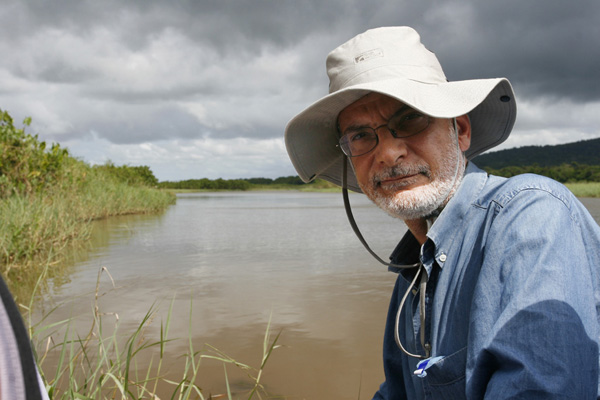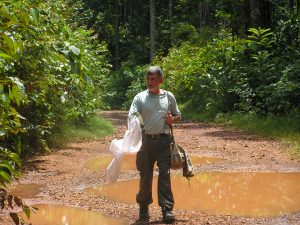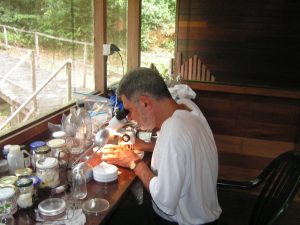A Passion for Life in Miniature
by Marika Azzopardi

They consume up to 25% of all crops and grains gathered worldwide and can easily spoil all the rest. They occupy every niche of our planet and can associate themselves intimately with most other organisms. No, they are not aliens trying to take the world over. They already own the world – they are insects. They are also the territory of Dr Paul Gatt, consultant dermatologist by profession and entomologist by passion.
Studying an organism which can span the grandiose width of 3mm or even less….a microscopic 1mm, is not something most of us would take up gladly. Yet Dr Gatt claims this was his fascination from childhood.
“I used to spend many happy hours pottering about in a field near my home seeking them out – turning a stone here, looking at a flower there – not understanding much, but still marvelling at their number, beauty and endless variety of form and colour as they quietly went about their daily lives.”
Great things begin in such simple manners that are tinged by inbred inquisitiveness. Although the study of insects might not sound like a big deal, there is more to insects than we credit them for. Dr Gatt explains the widespread influence they have over our civilisations. “For one thing insects are extremely adaptable, with some species living in glaciers, thermal springs, and even crude oil! Their sheer numbers provide food for countless birds, fish and other forms of life. They are vital elements of the food chain when we consider their importance as pollinators of crops and grains that provide the bulk of the world’s food. Insects are equally vital in decomposing decaying matter without which the earth would be littered with dung and dead bodies. And, from a purely anthropocentric point of view, they are responsible for spoiling much of the earth’s crops and grain and costing millions of lives in deaths from insect-borne disease.” Not very exhilarating news!
Considering the fact that only one million species are known to scientists and yet a staggering seven million are estimated as still waiting to be discovered, Dr Gatt was surely right into entering an area of research with much potential.
Starting off from the ‘large’ specimens the likes of butterflies, beetles and bees, insects that titillate the curiosity of just about any average child, his research took him to smaller and smaller insects which became definitely harder to study.
“I must admit that joining the Natural History Society of Malta, way back as a youth, helped me form my interest better. It was there that I met wonderful naturalists and teachers – people like Guido and Edwin Lanfranco, Patrick Schembri, Joe Cilia and Anthony Valletta – who inspired me greatly. The enthusiasm at the society was infectious, and a number of us – Albert Bezzina, Noel Camilleri, Carmelo Aquilina (all of them medical doctors now), James and Stephen Schembri, Louis Cassar, David Mifsud and Guido Bonett met during the Society meetings and became life-long friends.”
“I owe my first beginnings in entomology to Joe Cilia who patiently and enthusiastically endured the company of a 13 year old boy who never seemed to stop asking questions! I used to accompany him on collecting trips, and it was he who taught me the initial field and curatorial skills necessary to build up an insect collection. Once a week I used to visit him at his home, and he would give me the names of the insects I had collected, with explanations of how they lived and what they did. I marvelled at the diversity of insect life even in a small place like Malta.”
Today he is practically the only active medical authority in entomology in Malta and whilst he admits he would have taken up entomology had he had the opportunity to do so, he does find that entomology aids him in his work related to the human skin.
“I can understand better the skin diseases and internal illnesses caused by insects. My travels have aided me in this respect and whilst I began by researching the Mediterranean basin initially, I did move out to diverse countries such as South America or Ethiopia to experience insect life there as well.” Training to observe minute creatures also helps aid his eyes in detecting subtle skin manifestations that can indicate disease.
Meeting Martin Ebejer, a fellow physician who had just returned to Malta from the UK – at that time already a highly skilled and experienced dipterist – was tantamount to consolidating his interest in entomology. He frankly admits, “Were it not for his influence and enthusiasm I doubt if I would have ever returned to entomology, an interest I had to shelve because of my specialisation in dermatology. Martin introduced me to the rigours of taxonomy and generously shared his literature and contacts with international experts and museums with me. John C. Deeming of the National Museum, Cardiff introduced me to a family of tiny flies – Sphaeroceridae – which would occupy most of my interest for the coming years. What began as a simple hobby transformed itself into a serious and rewarding study, and I found myself plunging deeper into diptera morphology and systematics, which interest me particularly for their astounding biodiversity.”
He kicked off his studies by honing in on Maltese fauna but then broadened his experience by collecting first in the UK – where the fauna was well known – and later in many places around the Mediterranean basin, including North Africa. “Fauna of North Africa is also very poorly known, and more recently I also experienced the tropical rainforests of French Guyana. With Martin Ebejer’s encouragement, I began compiling my findings which included those related to four species new to science from Malta and elsewhere, and publishing them in international peer reviewed journals. My collaboration with foreign specialists also resulted in two previously unknown species being named after me – Platypalpus gatti and Tethina gatti.”
What about Malta’s urbanisation – is it destroying insect existence on a local level? “A lot is fast disappearing, but the insects I study are minute creatures which you wouldn’t see easily with the naked eye. You have to know where to find them by knowing what they do. And pockets of life are still to be found fortunately teeming with insect life that interests me.” It is around these pockets of life that Dr Gatt collects specimens of Diptera in order to study them better, first by mounting, dissecting and scrutinising them, then by documenting their structure. It is a process which Dr Gatt admits can be extremely taxing, time consuming and tedious.
And the fascination continues. Certainly Dr Gatt is a well of information about a world we generally ignore and at best merely acknowledge. The papers Dr Gatt has written may not be interesting to many except perhaps a handful of similarly inclined scientists and he admits, “I do all my entomology in my limited spare time, and my only regret is that I will probably never finish off what I have already started.” The time is probably ripe for more scientists of this calibre to delve deeper into nature’s uncharted mysteries.



